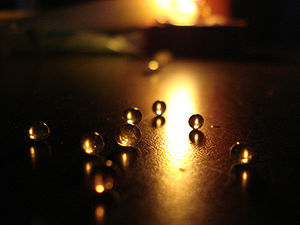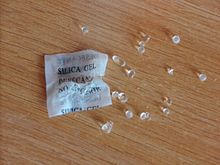- Silica gel
-
Silica gel 
Identifiers CAS number 63231-67-4  , [1][2]
, [1][2] gel (verify) (what is:
gel (verify) (what is:  /
/ ?)
?)
Except where noted otherwise, data are given for materials in their standard state (at 25 °C, 100 kPa)Infobox references Silica gel is a granular, vitreous, porous form of silica made synthetically from sodium silicate. Despite its name, silica gel is a solid. It is a naturally occurring mineral that is purified and processed into either granular or beaded form. As a desiccant, it has an average pore size of 2.4 nanometers and has a strong affinity for water molecules.
Silica gel is most commonly encountered in everyday life as beads packed in a vapor-permeable plastic. In this form, it is used as a desiccant to control local humidity in order to avoid spoilage or degradation of some goods. Because of poisonous dopants (see below) and their very high absorption of moisture, silica gel packets usually bear warnings for the user not to eat the contents.
Contents
History
Silica gel was in existence as early as the 1640s as a scientific curiosity.[3] It was used in World War I for the absorption of vapors and gases in gas mask canisters. The synthetic route for producing silica gel was patented by chemistry professor Walter A. Patrick at Johns Hopkins University, Baltimore, Maryland, USA in 1919.
In World War II, silica gel was indispensable in the war effort for keeping penicillin dry, protecting military equipment from moisture damage, as a fluid cracking catalyst for the production of high octane gasoline, and as a catalyst support for the manufacture of butadiene from ethanol, feedstock for the synthetic rubber program.
Properties
Silica gel's high surface area (around 800 m²/g) allows it to absorb water readily, making it useful as a desiccant (drying agent). Once saturated with water, the gel can be regenerated by heating it to 120 °C (250 °F) for two hours. Some types of silica gel will "pop" when exposed to enough water. This is caused by breakage of the silica spheres when contacting the water.[4]
Preparation
A solution of sodium silicate is acidified to produce a gelatinous precipitate that is washed, then dehydrated to produce colorless silica gel.[5] When a visible indication of the moisture content of the silica gel is required, ammonium tetrachlorocobaltate(II) (NH4)2CoCl4 or cobalt chloride CoCl2 is added.[5] This will cause the gel to be blue when dry and pink when hydrated.[5] An alternative indicator is methyl violet which is orange when dry and green when hydrated.
Applications
Desiccant
See also: DesiccantIn many items, moisture encourages the growth of mold and spoilage. Condensation may also damage other items like electronics and may speed the decomposition of chemicals, such as those in vitamin pills. Through the inclusion of silica gel packets, these items can be preserved longer.
Silica gel may also be used to keep the relative humidity (RH) inside a high frequency radio or satellite transmission system waveguide as low as possible (see also Humidity buffering). Excessive moisture buildup within a waveguide can cause arcing inside the waveguide itself, damaging the power amplifier feeding it. Also, the beads of water that form and condense inside the waveguide change the characteristic impedance and frequency, degrading the signal. It is common for a small compressed air system (similar to a small home aquarium pump) to be employed to circulate the air inside the waveguide over a jar of silica gel.
Silica gel is also used to dry the air in industrial compressed air systems. Air from the compressor discharge flows through a bed of silica gel beads. The silica gel absorbs moisture from the air, preventing damage at the point of use of the compressed air due to condensation or moisture. The same system is used to dry the compressed air on railway locomotives, where condensation and ice in the brake air pipes can lead to brake failure.
Silica gel is sometimes used as a preservation tool to control relative humidity in museum and library exhibitions and storage.
Other applications include diagnostic test strips, inhalation devices, syringes, drug test kits and hospital sanitation kits.
Chemistry
In chemistry, silica gel is used in chromatography as a stationary phase. In column chromatography, the stationary phase is most often composed of silica gel particles of 40-63 μm. Different particle sizes are used for achieving a desired separation of certain molecular sizes. In this application, due to silica gel's polarity, non-polar components tend to elute before more polar ones, hence the name normal phase chromatography. However, when hydrophobic groups (such as C18 groups) are attached to the silica gel then polar components elute first and the method is referred to as reverse phase chromatography. Silica gel is also applied to aluminium, glass, or plastic sheets for thin layer chromatography.
The hydroxy (OH) groups on the surface of silica can be functionalized to afford specialty silica gels that exhibit unique stationary phase parameters. These so-called functionalized silica gels are also used in organic synthesis and purification as insoluble reagents and scavengers.
Chelating groups have also been covalently bound to silica gel. These materials have the ability to remove metal ions selectively from aqueous media. Chelating groups can be covalently bound to polyamines that have been grafted onto a silica gel surface producing a material of greater mechanical integrity. Silica gel is also combined with alkali metals to form a M-SG reducing agent.
Silica gel is not expected to biodegrade in either water or soil.[6]
Cat litter
Silica gel is also used as cat litter,[7] by itself or in combination with more traditional materials, such as clays including bentonite. It is trackless and virtually odorless. Purchasing silica in the form of cat litter can be an easy and cost effective way for retail consumers to purchase silica gel for use in other applications, such as maintaining the desired relative humidity in humidors, keeping tools or other materials rust-free in damp environments or long-term storage, and preserving dried food.
Hazards
Silica gel is non-toxic, non-flammable, and non-reactive and stable with ordinary usage. It will react with hydrogen fluoride, fluorine, oxygen difluoride, chlorine trifluoride, strong acids, strong bases, and oxidizers.[6] Silica gel is irritating to the respiratory tract and may cause irritation of the digestive tract, and dust from the beads may cause irritation to the skin and eyes, so precautions should be taken.[8] Some of the beads may be doped with a moisture indicator, such as cobalt(II) chloride, which is toxic and may be carcinogenic. Cobalt (II) chloride is deep blue when dry (anhydrous) and pink when moist (hydrated).
Crystalline silica dust can cause silicosis but synthetic amorphous silica gel is non-friable, and so does not cause silicosis.
References
- ^ Silica gel, site www.jtbaker.com
- ^ Silica gel, site www.chemcas.org
- ^ Maryann Feldman and Pierre Desrochers (March 2003). "Research Universities and Local Economic Development: Lessons from the History of the Johns Hopkins University". Industry and Innovation 10 (1, 5–24). http://www.rotman.utoronto.ca/feldman/papers/Research%20Universities%20and%20Local%20Economic%20Development.pdf.
- ^ http://m.wpi.edu/Pubs/E-project/Available/E-project-042607-140508/unrestricted/MQP-RWT-606.pdf Spence Konde, "Preparation of High-Silica Zeolite Beads From Silica Gel," retrieved 2011-09-26
- ^ a b c Greenwood, Norman N.; Earnshaw, Alan (1997). Chemistry of the Elements (2nd ed.). Oxford: Butterworth-Heinemann. ISBN 0080379419.
- ^ a b Environmental Health and Safety (2007-09-10). ""Silica Gel"". http://hazard.com/msds/mf/baker/baker/files/s1610.htm. Retrieved 2008-01-12.
- ^ Andrew Kantor (2004-12-10). ""Non-Tech High Tech Litters the Landscape"". USA Today. http://www.usatoday.com/tech/columnist/andrewkantor/2004-12-10-kantor_x.htm. Retrieved 2008-03-02.
- ^ Fisher Scientific (1997-02-09). ""Silica Gel Dessiccant"[sic]". http://www.atmos.umd.edu/~russ/MSDS/silicagel28200.html. Retrieved 2008-01-12.
External links
- Silica gel mesh-metric conversions
- Record in the Household Products Database of NLM
- UK Material Safety Datasheet
- Silica Gel with Moisture indicator: Instructions for Use Detailed use and re-drying info
- Silica Gel Dehumidifier FAQs Helpful Information on Rechargeable Silica Packs for Home Usage
- Silica-bound reagents Information on development and Tables illustrating reactivity
- Silica-bound scavengers General notes and Tables that summarize scavenging capacity
- Education Center
Categories:- Desiccants
- Gels
- Glass types
- American inventions
- Silicon dioxide
Wikimedia Foundation. 2010.


